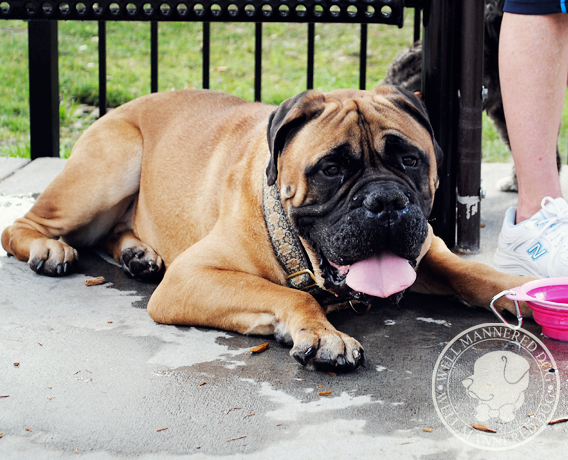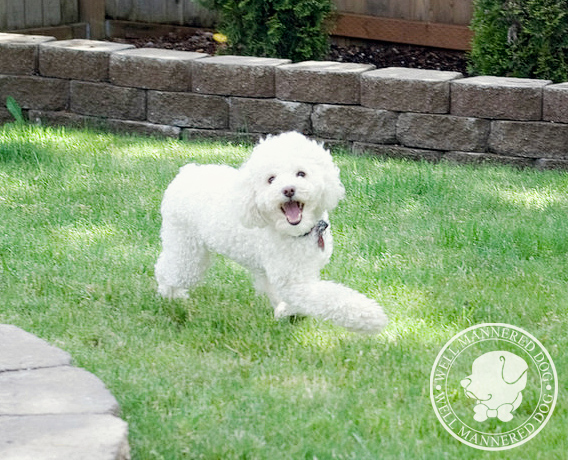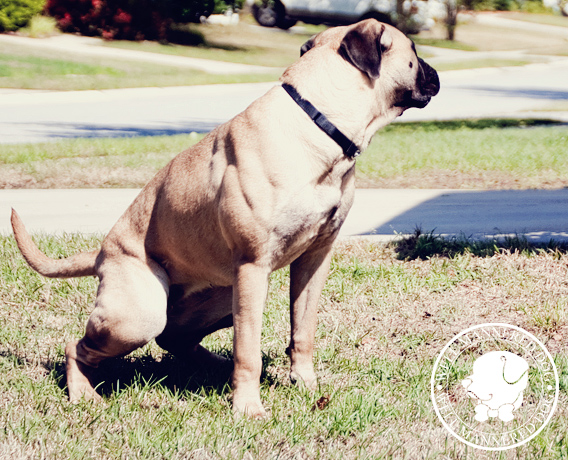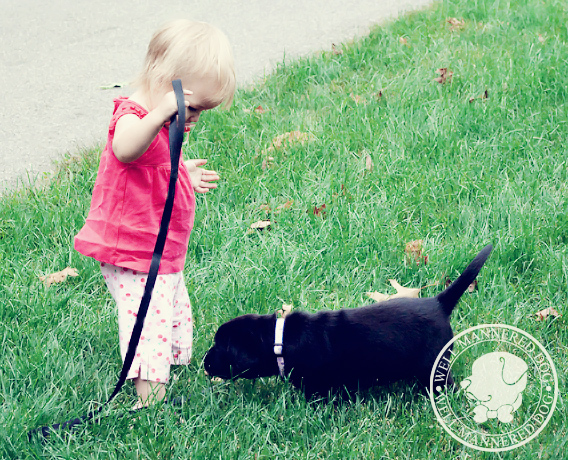
Well Mannered Dog | Charleston Dog Trainer | Charleston Dog Training
Signs of an Overheated Dog

How to tell your dog is overheated and what to do about it.
It’s that wonderful time of year again. The sun is shining, the days are warm, and outside activities are on everyone’s to do list. The Lowcountry boasts many dog friendly restaurants, parks, and beaches where you and your furry friend can enjoy a quick outing together or make a whole day of it. However, the heat can get oppressive for human and canine alike, and overheating is a real and deadly health concern for dogs. Learning the warning signs and what to do about them can save your dog’s life.
Every dog can overheat. Once a dog has done so, they are more susceptible to do it again. The short nosed brachiophelactic dogs (Pugs, bulldogs, or anything without the longer canine snout) are doubly sensitive. When a dog’s temperature begins to rise, they pant to cool themselves down. Fortunately, this exposes their tongue and gums which is first thing to keep an eye on to monitor for overheating.
LOOK
Become familiar with your dog’s normal tongue color. When your dog is panting and the color begins to darken, you know that the body is beginning to struggle with cooling. This is the time to act. Offer your pet cool water. Get to a shady spot and encourage your pet to lie down. Wetting the underside of the dogs body in the “armpits”, both front and rear can assist in cooling. Also, wetting the muzzle will help the dog. If you have a long haired or thick coated dog avoid fully saturating the whole animal at this point; concentrate on the muzzle and underside where the blood runs close to the skin.
LISTEN
Once your dog is in a shaded area and you are applying water, take a moment to listen to your dog. If the dog’s breathing rate is very rapid, it’s time to head out and find some air conditioning. If there is a “rasp” to the breathing then you could be nearing a medical emergency. Saturate the dog if possible. An alcohol based antibacterial gel can be applied to the pads of the feet to aid in cooling, or rubbing alcohol if you have it on hand. Once the dog is wet they can be placed in front of a fan if one is nearby. Do not use ice to aid in cooling; bringing the body temperature down too fast is a concern. If possible, take your dog’s temperature. Continue your cooling efforts until it reaches around 104.
TOUCH
Feel the consistency of your dog’s saliva. If it is thick or sticky then your dog is dehydrated. Dehydration can happen rapidly when fighting an overheating episode. If vomiting occurs then a vet visit is in order. Your vet can continue to cool your dog while giving it fluids. If the saliva is thick and the dog refuses fluids, again, time for the vet. Dehydration is nothing to toy with when your dog is overheating.
If all of the cooling steps have been taken and the dog is not cooling down it should be considered a life and death emergency. Get your dog to the nearest veterinary facility. Do not try to drive to your own. If it is after hours, then an emergency vet visit is warranted. Thankfully, if owners keep a vigilant eye and plenty of cool water on hand overheating can be easily remedied before it becomes serious.
No Stress in Springing Your Dog Outside

Yard Manners take a little training and some supervision.
It’s beginning to warm up and spring is in the air! I don’t know about you, but my dogs and I like to be outdoors as much as possible during this wonderful time of rebirth and green. We look forward to warmer weather and more time outside. As a dog owner, you probably feel that this is a time that your dog can experience more freedom. If done correctly, this can and will be a great experience. If not done correctly, mischief and mayhem can ensue. Here are some helpful hints to make your backyard time with dog during the spring less stressful:
- Boredom can lead to big problems! If you leave your dog outside without helping them to release their physical and mental energies beforehand, you may find that they will most definitely become creative. Their projects can range from a small hole to a knocking over your prized grill to tearing down or redecorating your deck and lawn furniture. Alone time outside does not replace walking or mental exercise. It is not an automatic relief of stored up energy, at least not in a consistently positive manner. A relaxing nap underneath a tree outside will only result when the dog is exhausted. Make sure to set your dog up for success and not put your them in a position to express their creative energies in a way that would not make you proud. Remember: A tired dog is a good dog.
- A watched dog is a better dog. Do not leave your dog in your yard unsupervised, especially if you expect them to behave. If regularly attended, the dog will understand that outside is just like inside: you are the leader and they need to listen. New sights, new sounds, looser dirt, small animals beginning their springtime frolic, and increased daily sunlight are all invitations for a grand canine adventure. If you would rather your dog not take part in these activities, you need to be consistent with your training and supervise.
- Remain in control. Remember, a long line (30 feet) can give your dog an increased area to play while you remain in control. Even if your dog is reliable off the leash, it may take a couple of days to remind them how to behave in their changed environment. Without a leash, this becomes much more difficult. I never recommend a remote collar without proper training.
- Canine-proof your yard as much as possible.
- Dogs are creatures of habit. Do not assume that your dog will be happy to be outside. Banishing them to the great outdoors while you are away can create stress. Many dogs would be happier to remain surrounded by the familiar sights and sounds inside that can remind them of their place in your home. If they are used to being in a crate, it is relaxing for them to remain in their routine.
Treat on the Nose a.k.a Patience!

With some practice and a lot of patience, you can teach your dog the treat on nose trick.
Let’s teach your dog a trick that reinforces patience with food! Try the following steps to train the Treat-On-The-Nose trick! Brush up on your sit-stay before you attempt this trick. Your dog has to sit perfectly still to hold the treat! This trick requires a lot of patience on both parts. Be prepared to stay calm and not get frustrated. Remember this is something fun for you and your dog, not a requirement!
- Start with a sit-stay directly in front of you while you sit in a chair. Their head should be slightly resting on your lap.
- Put one hand under the dog’s head and raise its nose until it is level to the floor.
- Place the treat slowly and gently on the flattest part of their nose.
- While you rest their muzzle in your hand, alternate praise with the phrase “Hold It!” in your command tone.
- After a few seconds, release him, praise him, and let him flip the treat off his nose and eat it.*
- Repeat this process five to ten times per day for several days.
- As your dog begins to hold their own head steady, begin to remove your hands slowly from their muzzle to let them do it alone.
*Some dogs will drop the treat on the floor and pick it up. Others will flip it into the air and catch it. If you want the flip method and your dog is a “dropper”, immediately command them to “leave it” if they drop it. Let them take it if they flip it. With consistency, this will condition the dog to flip it. If they do not catch it on the first flip, praise the effort with “good dog!” so that they do not give up. When they do catch it, praise vigorously! Have fun!
Potty in One Spot

Make your life easy! Train your dog to potty in one spot in your yard.
“Watch where you step! We haven’t poop scooped in a while”. Wouldn’t it be great if you could just get your dog to go to the bathroom in one spot? It sure is! That’s right! It’s possible, and it’s WONDERFUL. How? Ritual and repetition… Here is the list of ingredients and the recipe for the reduction of your clean-up time! Enjoy the reduced waste and burn marks on your yard!
The Ingredients
A Designated Space. Before you train, you must have a set area for your dog to use as its potty space. Everyone involved in the dog’s training should understand where this is. Make it easy for the humans and canines alike to quickly tell exactly where the potty area is. For example, I suggest using a bark mulched area or a pine straw area. This way, urine and feces will not burn your grass, and the dog will know when its feet have made it the right spot. Even if you move or go to a friend’s house, the dog can relieve itself off of the green space. If that’s not what you’d like, come up with another way for your dog to easily tell either visually or texturally.
A Designated Phrase. You will need to use cue words. You can use “hurry up”, “go potty”, “be quick”, or whatever works best for you. Everyone involved must use the same phrase. Before you train the spot, train the phrase to your dog. To do this: bring your dog out on a leash each time it has to go. Capture the action of going to the bathroom using your phrase. As soon as they start to go start repeating your chosen phrase over and over in a praise tone while your dog is doing their business. As soon as they stop, so do you. This way, they connect your phrase with the action of going. Once you have trained in this way for a week to ten days, you have prepared this ingredient and are ready for the recipe. Do not use your phrase as a command prior to their action until you have moved on to the recipe part of the training.
A Designated Path. At least at first, your dog must go down the same path to get to its bathroom every time it goes out. Make sure that the same door, the same path, and the same target area are used to show your dog the way to its “place of business.” Later you can show the dog alternative ways to its space, but first make sure there is only one pathway to success so that your dog doesn’t get confused.
The Recipe
Each time you take your dog out to do its business, put the dog on a 6 foot fixed leash (no retractable leashes – hear “no wire hangers” and you will know exactly how I feel about them). Go out the same door, and quickly move to their target area using your designated path. Then stand still. Do not allow the dog to smell the whole yard. A 6 foot radius is more than enough to find their spot. Say your designated phrase one time in your command tone. Wait. As soon as they go to the bathroom, again capture their good work using your designated phrase in praise tone repeatedly during the conduct of business. As soon as they finish, give the command “Inside!” and run back to their designated door using their designated pathway. Congratulate them using enthusiastic petting and verbal praise when they arrive! Throw your dog a party!
If you always do your ritual in exactly this way, you will get a dog that goes to the door and asks for relief, then goes to a target space, does its business, and comes right back. Make sure that if you are going to play in the yard, do your ritual, including the return and celebration portion, prior to letting your dog back out to the yard to play or go for a walk.
Getting Kids To Help with Dog Training

Always Supervise Your Child While Working Commands
So, you’ve got a dog and you’ve got kids. What can you do to get the two to mix in a way that is positive and rewarding? LOTS OF THINGS! Here are just a few ideas:
Cheerleading!
When you are teaching a dog its commands, and it begins to clue in on the routine, kids can be great cheerleaders! Have them stand by on the ready to praise the dog and love the dog (without over exciting them to the point of losing focus) when they do something right! Make sure the praise comes at the right time: when the dog is doing what it is meant to do. Your kids will learn appropriate praise times, and your dog will learn to behave! If you are using clicker conditioning, and your dog can take the treats nicely, let your child be the “candy machine”! Praise is any form of the dog getting what it wants: attention, praise, play, treats, petting, etc. Cheering for a dog can include any of those things.
Hide and Go Seek!
Reinforce your “come” command by playing Hide and Go Seek! That’s right! Put your dog in a sit/stay. Have your child hide. When you give a predetermined signal (“you’re through” releasing the dog from its stay is always a good one, but a whistle or a clap will work too), have the child repeatedly call your dog’s name and say your family’s come command over and over again. When they hear the dog coming, tell them to praise their dog. Make sure your child makes it really exciting for them to be found. Upon finding your child, make sure the dog is commanded to sit. Then give lots of love! Your dog will rush from hiding spot to hiding spot to find your child to be rewarded with their attention. If you want to, you can also change it up by adding a new “FIND” command. Make the signal to your children to begin their calls when you say “FIND [insert child name here]”. Then they can go find that person for you! This is helpful when you want to burn mental energy as well as physical energy for both the dog and the child. That can come in handy when its raining outside!
Double Leashing
What do you do if you have children in your home that want to help with the training of the dog? By all means, let them. But be smart about it. Letting a child handle the leash of a dog, or give the dog commands can only be done in one of two cases: (1) the dog is more than proficient and consistent with its obedience, or (2) you are there to assist them. Never train the dog around a child if you are not confident in your ability to command your dog. You don’t want to inadvertently exhibit any negative behaviors in front of your “student trainer”. Never have a child, especially a small one, give commands or handle the dog without supervision. With that said, here is a great way to help your child to gain an understanding of canine ownership and companionship: double leashing.
When you are working with your dog, put two leashes on them. One that is longer for your smaller partner, and one that is shorter for you. With this in place, you can teach your partner proper leash handling and command techniques, while maintaining the ability to reinforce the commands for them in the event they are unable to do so themselves. For instance, if your student gives your dog the command to SIT/STAY with the correct tones and hand signal, and your dog does not do it: Have your child/student say NO, and then (assuming they are unable to) you step in and correct the dog by placing them in the correct position. Praise your child for their correct performance, and have them try again. With practice, your dog will understand that the child has the power to command them. This can also be useful when walking your dog. If you are working on control walk, have the child walk with the longer lead, while you work the shorter one. If the dog will walk with you in a heel position, all the better. Step off onto your walk with your dog in heel, while your child leads or follows using the longer lead. They are helping you to walk the dog! Then try having your dog heel to your child, while you reinforce with leash corrections when necessary. Remember, to be consistent your students (dog and human) must perform their tasks in a way that is consistent with your training so that you don’t lose any of your hard work!
© 2013 Well Mannered Dog Training Charleston, SC
TAGS: Health